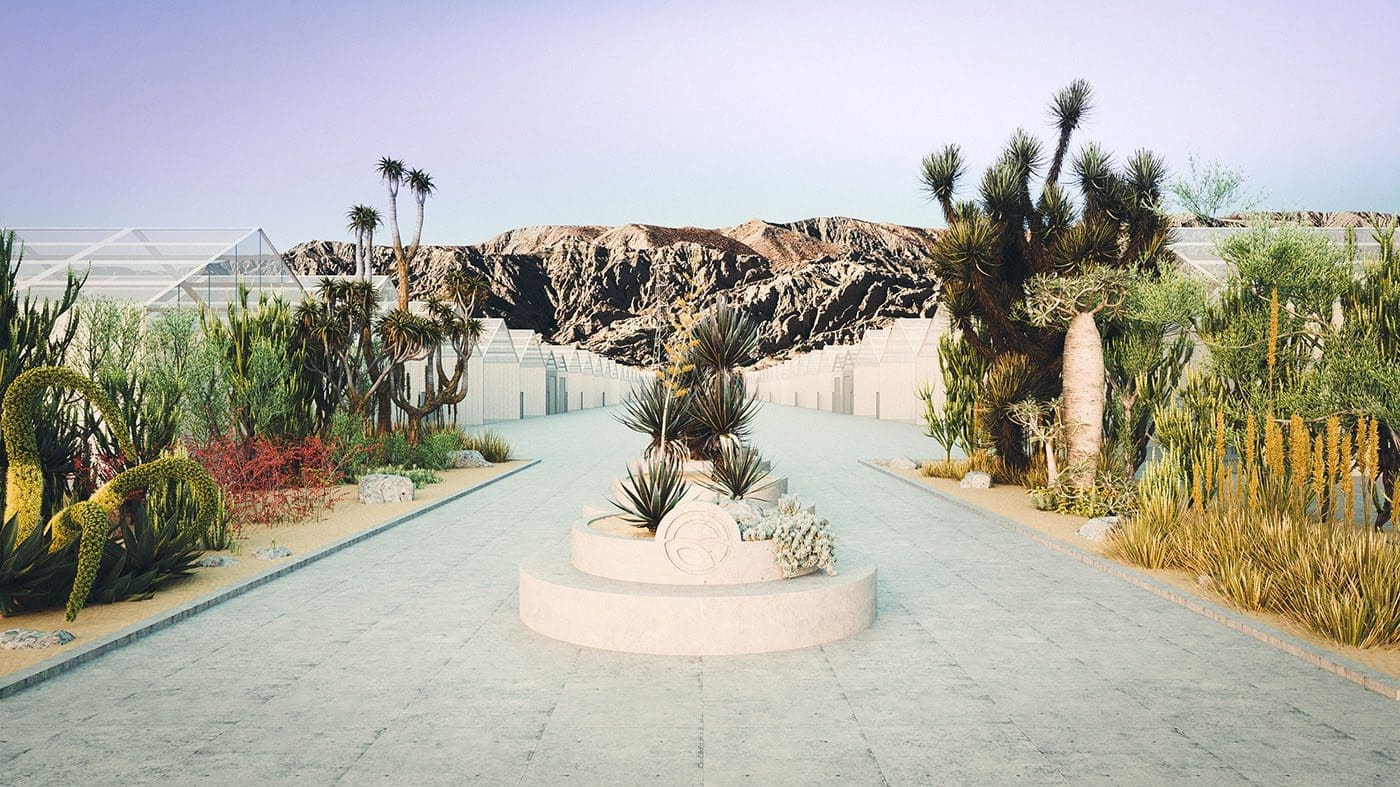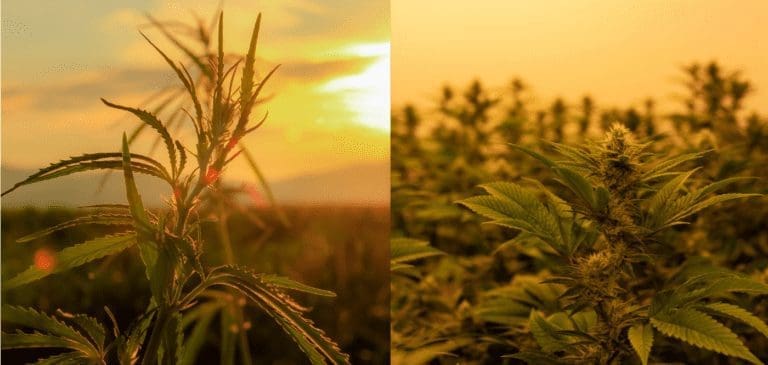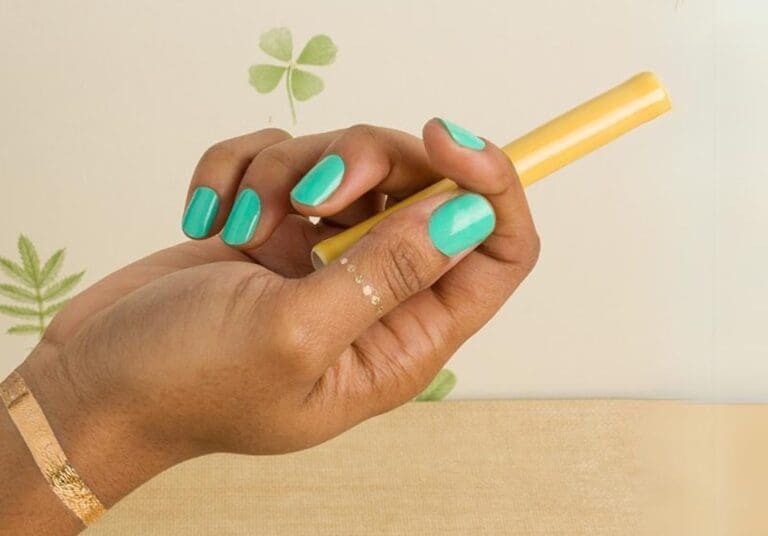Why Green Horizons is taking the cannabis plant to exciting new places
- Carlos “Los” Arias started his relationship with the cannabis plant early.
- Los Arias is the co-founder of Green Horizons, a first-of-its-kind cannabis cultivation, brand incubator, and education facility in the Coachella Valley.
- Green Horizons is on a mission to reframe the way people view and experience the cannabis plant.
- With Tommy Hilfiger on their team, one of their many innovations will be fashion crossover brands.
16-minute read
Los’ Start With Plant Medicine and the cannabis plant
Plant medicine has been integral to Los Arias’ life since he was young. When he was battling cancer, it literally saved his life. But the cannabis plant, specifically, has been his focus for the past several years. While still in law school, he learned the ins and outs of the regulated cannabis industry at RiverRock Cannabis. Now, he’s spearheading the creation of Green Horizons with a first-of-its-kind cannabis cultivation campus in Coachella, CA. In addition to hundreds of thousands of square feet of greenhouses, Green Horizons will offer tours, education, and workshops to the public. Green Horizons’ debut brand is a collaboration with the fashion world. They’re partnering with Tommy Hilfiger, who only recently openly connected himself with cannabis. Just after the initial press release went out, we sat down with Los to find out what else we can expect from his unprecedented new venture.
You’re a veteran in this nascent industry—tell us about your journey.
Serendipitously getting started in cannabis
In 2014, one of my friends needed to recapitalize his cannabis business in Colorado. He needed $2,000,000, and it was very difficult to raise that kind of capital then. I was going to law school at the time, but never had an intention of being an attorney. I had ties to a family office in the Dominican Republic that had backed me on other ventures. In the Dominican Republic, the cannabis plant is super frowned upon. But these folks were willing to explore a new sector under the auspices of my stewardship. They said, “You know, Los, you’re crazy enough to see something like this through.” So I was able to come through for my friend, but I told him, “There’s a catch. You got the $2 million. Now you have to teach me the regulated market.”
From plant medicine to the cannabis plant
I was able to enroll in the part time program at my law school. Thus, I was in Denver every week at RiverRock—Monday through Thursday—learning from my friend, Norton Arbelaez. Then I’d fly to LA to do my law classes on Friday and Saturday. Then I’d fly back on Sunday to Denver. Rinse and repeat. I did that for 2 ½ years, studying on the plane rides. So I earned my JD, and then I learned the regulated cannabis game from someone who’s a true pioneer. I’ve always had a green thumb. So that part was easy for me, as I had worked with plant medicines of all kinds for years. That was my initial springboard in aligning with the plants, harnessing my family’s Brazilian lineage. Arbelaez was then responsible for teaching me how to operate in the regulated marketplace. I wouldn’t be here without him.
How did plant medicine save your life?
I was diagnosed with cancer several years ago. It came as a huge shock, and I was lucky enough to be referred to an incredible oncologist. It was somewhat advanced. So he put me on oral chemo, and that was able to stem the spread a bit. The next wave of treatment, however, was when he said to me, “Hey, man, have you ever heard of Kambo?” He knew that I was an Ayahuasca and a 5-MeO-DMT devotee because I had shared that with him. Thus, he figured I’d be open to alternative treatments for the cancer. He walked me through the utilization of this venom from the Amazonian monkey frog, and how there’s ample research behind it.
can Kambo treat more than cancer?
He’s actually spearheading the clinical trials right now with the FDA on the utilization of Kambo to treat a myriad of diseases. That includes cancer, Lyme disease, HPV, and autoimmune conditions of all kinds. I was all ears and grateful for his thinking outside the box.
What are Kambo sessions like?
The experience is a very challenging twenty minutes. The medicine itself is applied over your skin, and you immediately feel the effects. You start sweating and purging while this venom is coursing through your body and healing you. What’s incredible about Kambo is that it breaches the cellular wall. So it actually cleans you from the inside out. Those 20 minutes aren’t fun. But, once you do enough of it, you get better at it. I got to a point where I learned how to meditate to it. How you feel afterwards is difficult to describe. It’s euphoric. You feel energized.
What’s the background on Kambo as plant medicine?
Many indigenous tribes use Kambo before they go on their evening hunts. I had 15 sessions of Kambo administered in a 12-month period—which is a lot. But it completely healed me. I was so moved by the experience that I actually got a tattoo to commemorate the journey. I was utterly transformed in this process. Like, wow—I had never even heard of this medicine before, and how many more people can this help? Right?! It stoked a curiosity and a passion in me to be an advocate for those in need.
If you could help mainstream Americans understand only one thing about the cannabis plant, what would it be?
That it’s medicine. We’ve been programmed for decades with misinformation. For me, it’s the ultimate crime against humanity. You look at Schedule I “drugs.” Of course, cannabis is there. And what else? DMT, 5-MeO-DMT, Psilocybin, Peyote, and LSD. These are the very same medicines and modalities that connect us to our spirits, to the cosmos, and to each other. But we’re not allowed to have those, right? Instead, they give us alcohol, pharmaceuticals, and pornography as a means of keeping our vibrations low. Everything has the capacity to be misused. But the cannabis plant is medicine at its core. And it brings people together. I feel the same way about the other medicines currently situated on Schedule I. The world is waking up to this farce, and humanity is embracing its inalienable right to cognitive liberty.
What’s the history of indigenous use of the cannabis plant?
Cannabis has a lot of Shitana, which is a shamanic term connoting “dark energy.” Think of it like the yin and yang. I learned my Ayahuasca practice through the Shipibo Indians in Peru. They’re very wary of cannabis because, in their eyes—and they’re probably right—a lot of people misuse it. Most people don’t understand that it’s not for escapism. There’s a way to approach cannabis with respect and reverence. That’s how you really derive a lot of value from the plant. Like anything else, you’ve got to approach it with love and use it in a way that’s in alignment with your highest self. There’s a nurturing relationship to be had with the plant. I try to bring awareness to that for people.
What was your first experience with the cannabis plant like?
I was probably about 12 years old. I’m half Brazilian, on my mom’s side. There’s a long lineage of shamanism and working with sacred plants through my mom’s mom—going back generations. So, for me, cannabis was indeed the gateway medicine to the other plant medicines. We’ve got to reframe that. Cannabis is not a drug. It’s a medicine.

How was your family a part of your first experience with the cannabis plant?
I had a cannabis ceremony with my grandmother, my mom, and some family members. It was the first time I consumed it. The connection that I felt to myself, my family, and to the universe beyond me was just incredible. That was the first step towards working with other medicines. The next one for me was Ayahuasca. That’s how it started. I was very fortunate that the cannabis plant was accepted, embraced, and promoted in my household in a very personal way—honoring the lineage, and setting the course of the rest of my life.
How do you hope Green Horizons will change how people experience the cannabis plant?
My mindset is that we want to build a company that’s inspiring. We want to create products that are sustainably cultivated, produced, and ultimately segue into brands that connect with people and bring them together. I’m a cancer survivor, and so is my partner, Michael Meade. We’re not doing this just for the money and a quick exit. We want to build a real sustainable business that makes a difference in people’s lives.
It’s taken us 6 years to create exactly what we want
We’ve taken our time to build it this way. It took my partner 6 years to buy all the real estate in Coachella that we’re now building out. A million square feet entitled, subsumed within a single campus. He then had to get the entitlements approved by the city. Plus bring the power and the sewer. It was an arduous process, and I was with him every step of the way. We were very, very quiet about it. Our whole thing was, speak softly and carry a big stick. Don’t make announcements for the sake of announcements. Just focus on execution.
We did everything on our terms and in our own time
We had a lot of unsolicited offers in 2018-2019, when the Canadian RTO moment was in full swing. People were like, “You’ve got a lot of square footage. You should be part of our roll up—hold our paper and take a little bit of cash.” None of that was interesting. I was like, let’s take our time. Let’s build something of value, and let’s make meaningful strategic relationships in the process.
How does your co-founder make what you’re creating even more significant?
The highlight of that journey for us was definitely aligning with Tommy Hilfiger. With him on the ticket as a meaningfully involved co-founder, I think we have an opportunity to do something that’s unique and special. Something that can stand the test of time. And that’s what inspires us to get out of bed every day and travail the vagaries of this demanding industry we’re in. The pioneers take the arrows, and we’ve taken our fair share. It’s been worth it.
Fave way to consume cannabis right now?
I wake up every morning and do meditation and breathwork. Then I make myself a bulletproof coffee. And I love cannabis tinctures as part of that ritual. There’s one in particular, Jenny’s Rose, that has stood out from the rest. Really unique, patented stuff. I’ve met the formulator and had the opportunity to really understand their process. And I’m really impressed. So I like to sprinkle some of that into my coffee in the morning. Then I go get the best workout ever after that and am on high vibration for the rest of the day. By the way, I did all of that this morning.
Do you consume at night, too?
Yes, Jenny’s Rose has a nighttime formula that’s wondrous and produces lucid dreams. I’ve also done a lot of psychedelics. So maybe there’s some neural pathways that are more open for me than most. My dreams are like mini Ayahuasca ceremonies at night! They are super vivid and alive. I’ve been really blessed to find a regimen that really works for me. That’s what plant medicine is all about—exploring what works for you in a safe way, with trusted guides and products along the way.
With Green Horizons, Tommy Hilfiger has openly connected himself with the cannabis plant—what’s the significance of that?
I think it helps with the mainstreaming of the conversation around cannabis. To have a businessman of his repute and his pedigree come into the space and embrace the cannabis plant in a public way is important. Cannabis 2.0 is heading towards US-led, CPG. I think everybody can agree with that. I think it’s a really wonderful opportunity to broaden the reach of the plant. There’s a lot of cannabis curious folks out there. I think somebody like Tommy coming into the space will open some hearts and minds, and give us an opportunity to reframe the narrative around the cannabis plant as a medicine that is accretive to a healthy lifestyle.
Working with an iconic fashion designer, do you see any similarities between cannabis and fashion?
Yes, I feel like people consume cannabis in a manner analogous to how they approach fashion, music, and culture. They want what’s fresh—the latest wares and what speaks to them. I think that’s a really unique dynamic to harness with Tommy’s pedigree. We’re particularly passionate about exploring the confluence of cannabis, sports, and fashion. I think that’s super interesting. What I really love about that is the ability to reframe the old (and misdirected) adage of the “lazy stoner” and that cannabis makes you dumb. No, it doesn’t. I, myself—and many people I know—use it to fuel an active and healthy lifestyle. That’s what we hope to reframe as a blossoming company within a blossoming industry. I think we have a unique opportunity to propel that energy forward with Tommy on our team.
What are the qualities you’ll focus on for Green Horizons’ in-house cannabis brands?
We’re building a high vibrational house of brands, buoyed by large-scale infrastructure to capture margins and control our destiny. That’s what differentiates our thesis, particularly in this market. To this end, let’s take a half step back. What you have today, particularly in California, is a lot of asset-light brands that don’t own any infrastructure. They have great IP, but they’re beholden to third parties for all things execution. When you really look at the merits of that business strategy, the margins are very thin. It’s hard to make money doing that. You’re depending on a lot of humans who aren’t within your own organization to deliver a consistent brand promise for your products.
Our goal is to make Green Horizons different from other cannabis plant companies
We’re trying to split that difference with Green Horizons, with a conscious undertaking to ultimately be able to cultivate, package and distribute our in-house brands. If something goes wrong, the only person I can blame is myself. I like that.
Sustainability is an important quality for Green Horizons
The facilities we’re bringing online are sustainable and imbued with low COGS throughout. They’re high tech, light deprivation greenhouses that harness the 300-days-a-year sunshine in the Coachella Valley. That’s the game plan. Other top operators are already striking a similar balance between low COGS and quality. It’s not easy to execute at real scale. But, if you can crack that code, I think you’re setting yourself up to be competitive no matter what the macro market conditions are—even if you’re beholden to the wholesale market. If you can actually build brands, however, and do that in a way that’s meaningful, now you’re capturing all that margin and upside. That’s a differentiated business that is de-risked from onset.

Tell us about the public education your company will offer about the cannabis plant.
We’ve got a million square feet all in, subsumed within a consolidated campus. We were touring some visitors the other day and they were like, “Man, you’re building the Disneyland of cannabis.” It’s an attraction for sure, particularly given that Coachella is also a global brand in its own right. People come here. Tommy is also a global player. Tying these elements together, it feels like a platform to really educate on a broader scale than most can contemplate.
How do you plan to support the local community?
Green Horizons is partnering with the City of Coachella in launching the Build the Valley Initiative. That will consist of 2 prominent initiatives. First, building infrastructure for the community. Second, advocacy for expungement and job creation, for which Green Horizons will create a dedicated Coachella Valley program. In addition to local community activism, Green Horizons is also invested in the sustainable future of the cannabis industry and is a member of an industry task force that’s comprised of top operators, financiers, and attorneys. Our aim is to eradicate the use of plastics in the cannabis supply chain.
What do you hope cannabis will look like in the US in 10 years?
In 10 years, I think you’ll see a shuddering of the MSO model. At its core, that’s a creature of the Canadian RTO moment of 2018-2019. The Green Horizons future, which is what I can control, is low COGS, California sunshine, and fueling CPG brands with global scope. With large-scale infrastructure in the Golden State (which has been the epicenter of cannabis culture globally for decades) and the requisite in-house expertise to build brands, we’re going to be well positioned no matter how interstate commerce ultimately rolls out. It may very well take 10 years. That’s all the more reason to be nestled within the largest cannabis market on the planet.
How can we keep up with you and Green Horizons?
That’s all coming. Late summer/early fall, we’re going to turn the jets on with our social presence and really get ready for our debut brand—which is a crossover from the fashion world. The launch will be later this year in California, with multi-state partnerships to follow. More soon on that front. We have an incredible PR team in the Prismatics. To boot, our inaugural press release in April reached 500M impressions globally, including getting picked up by Bloomberg. What we’re building is global in scope and rooted in business fundamentals applicable to any industry. We’ve also got a couple of tricks up our sleeve that we’ll be releasing here sequentially in due time. Stay tuned!






